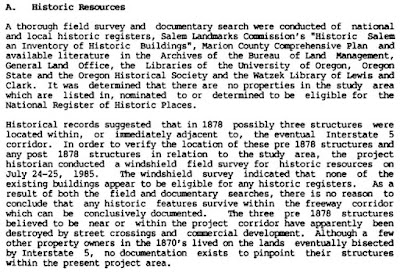 |
| Adam Stephens house of 1876 (History of Hayesville Church) |
Hopefully you saw in the Sunday paper the history column on "Sgt. Major John W. Jackson [and] his indomitable wife Caroline Woodson Jackson," who moved to Salem in the 1880s, initially had a farm in Hayesville, and are buried in the Hayesville Cemetery. It was full of interesting details.
 |
| On a Black Civil War veteran in Sunday paper |
The Hayesville location and link to Adam Stephens spurred circling back with some new ideas on finding historic places impacted by I-5. You will recall the initial concept for a Salem bypass, which then was absorbed and built up as the alignment of I-5.
 |
| January 7th, 1952 |
The bypass intersected the old highway, still 99E/Portland Road, at the Hayesville Cemetery.
And sure enough, the 1876 house of Adam Stephens was apparently demolished for the route. (The photo at top has a hand-written mark for 1955, but the 1954 news article says "wreck it within 30 days." I have not found confirmation of any demolition, however. Still, a misdating on the photo seems most likely.)
 |
| June 2nd, 1954 |
The piece:
This community's most historic landmark will soon be gone with the new highway taking its place. Where once an open well stood with a coconut cup on a nail for thirsty strangers, soon a wide strip of paving will lie.
The old "Halbert house," 4240 Portland Rd., was sold by the State Highway Department at public auction recently for $100 to C. W. Morrisett, 2470 Myrtle Ave., who must wreck it within 30 days.
Morrisett plans to salvage some materials and to sell much of the original casings, doors and trim.
Built in 1876 by Founder of Hayesville
The house was built by Adam Stephens, founder of Hayesville, in 1876, and is little changed from that time. The rear kitchen is from his original 1850 home. Stephens came to Salem from Missouri by wagon train in 1849. In 1850, he purchased a donation land claim of 533 acres for a pony, muzzle-loading shotgun, and $30 cash.
This donation land claim reaches south to north from the L. T. Reynolds home (across highway from Hollywood Bowl) to the Green Apple market. It extends west to east from the Oregon Electric tracks to the Hayesville Cemetery.
Stephens donated the lumber for the first school erected in 1858. This burned in 1951. He was a charter member of the Salem First Baptist church in 1859. Stephens founded the Sunday school here in 1883, and the Hayesville Baptist Church in 1888. The church was built in 1890 and was burned in 1941. He died in 1891, aged 72.
Lent Name to Church
One of Stephen's daughters, Mrs. Lucinda Berrilla Halbert, stayed on in the house with her husband, Madison. She was a foremost supporter of the little church until her death at 80 in 1942. The new church is named the Halbert Memorial Baptist Church in her honor.
Last Pioneer Building in Community
Now with the ordered destruction of the stately, two-story, old house with its balcony and gingerbread, there remains nothing of the original pioneer buildings in this part of the community.
Within the last month two huge, old barns were torn down on the Jacob Denny and Horace Smith, property. These were made with wooden pegs and square nails. Long since gone is the Stephens barn which once stood on the Jimmy Kapphahn property.
Near this barn Albert Stettler recalls helping hoist an old hack onto the top of a ten-foot-high fir stump during Halloween eve while he was a young boy. Madison Halbert never did find out how it was placed up there.
Near the Horace Smith's barn still stands, and not for long, a fir tree under which" the Indians are supposed to have held pow-wows. Leather thongs were found in its upper reaches before it was topped.
And the south of the Halbert house, there stands a stately pine, also destined for destruction, which was carried as a seedling by Mrs. Halbert in a milkpan on her lap from Wilhoit Springs and planted sometime previous to 1885.
Blacksmith Shop Stood Across Street
Across from the Halbert house, where the Kapphahn home is being readied for removal to the west a short distance, once stood Adam Stephens' blacksmith shop. There anyone was welcome to come in, fire up the forge, and shoe his horses or shape some iron
Madison Halbert is remembered for the many times he cut fir boughs and laid them in the muddy road (Portland highway) to keep passing wagons from getting stuck.
But now, only the cemetery which harbors the Stephens, the Halberts, and many other families in its quiet, green, tree-shrouded expanse remains a remembrance of the pioneer founders.
This information was apparently lost. The 1986 draft Environmental Impact Statement, "Hayesville Interchange - Battle Creek Interchange, Pacific Highway," contains little, and does not reference the Adam Stephens house - though the details in it also suggest this particular research may not have been the highest priority.
 |
| Nothing about Adam Stephens house |
They are particularly cavalier about pre-settlement Kalapuya sites.
 |
| On pre-settlement Kalapuya sites |
More might turn up. And with the prospect of a tribal casino just kitty-corner across the interchange, pre-settlement history might get more attention.
Briefly elsewhere:


No comments:
Post a Comment